Walkabout In The Weminuche Wilderness
BY Herschel Smith“There are no socialists in the bush” – HPS
All of my physical training only barely prepared me for the difficulty of the Weminuche Wilderness (pronounced with the “e” silent). It’s National Forest land, not National Park. The Department of Agriculture no longer prints maps of the area, so we relied on NatGeo for the map, and it’s good, but not perfect.
We have a lot of ground to cover, including traveling with firearms, the modification I made to one of my guns for the trip, the actors in the event, the plan, and how and why the plan got modified on the second day. I have many observations of things I knew but forgot, knew but was reminded are important, and things that I didn’t suspect would be as important as they are. So let’s get started.
The Actors In The Event
HPS:
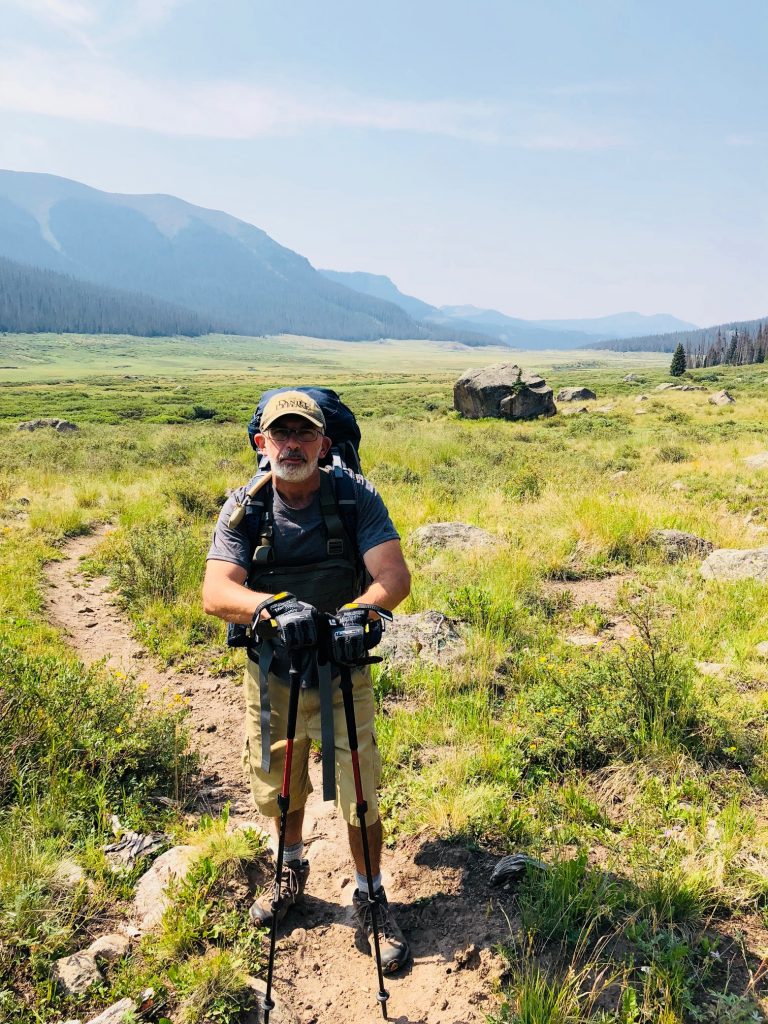
As you can readily determine, it makes no sense to include many photos of me on this blog.
Joseph, my dear second son:
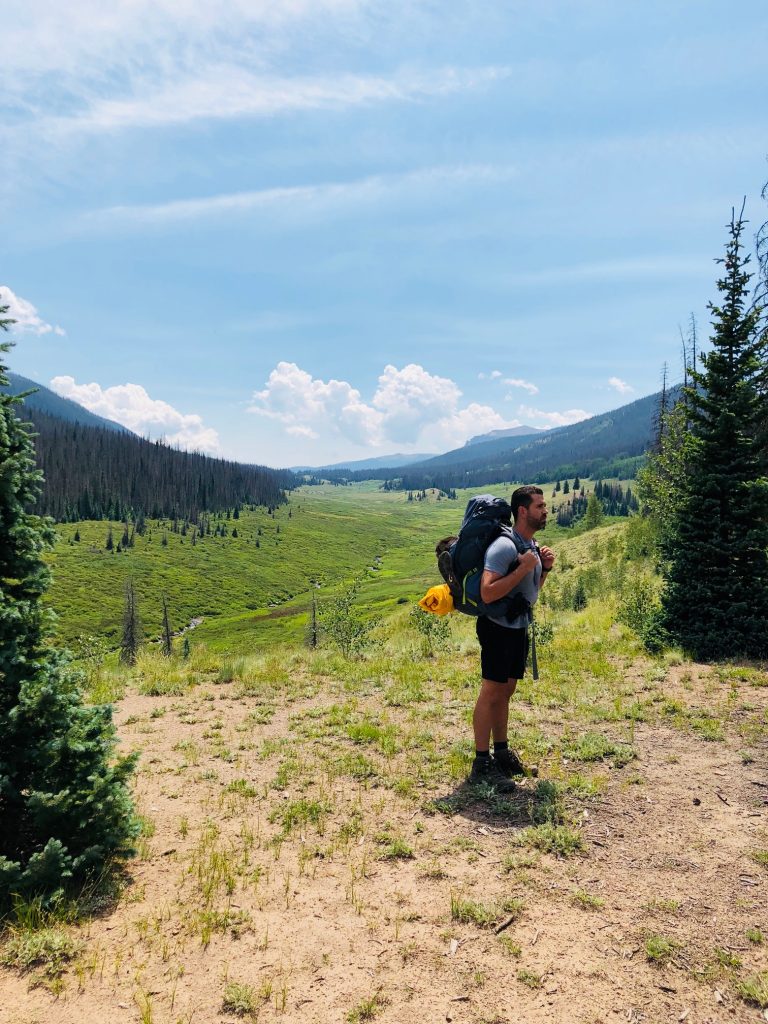
Joseph is the “Eveready Energizer Hiking Machine.” He has two speeds – flat out go and stop. He was my motivation during the trip, as he is in so much of life for everything else when I ponder just giving up.
Abraham Gonzalez:
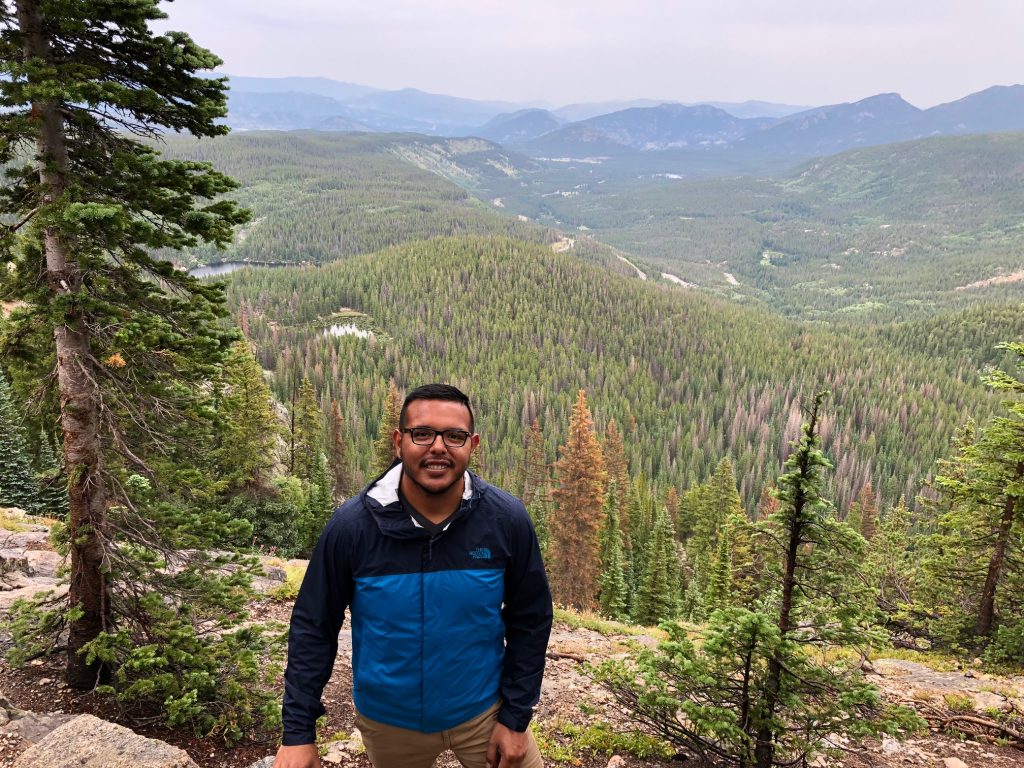
Abe is cool and easy to get along with. He makes heads explode in Austin, where he and Joseph are from, by telling people that he’s Hispanic, legal, grew up in America, is a Christian, believes abortion is sinful, voted for Trump, and wants illegals to be returned home without delay. He’s also a good hiker. We get along well.
The Plan And It’s Modification
We left from the Thirtymile Campground trailhead, but unfortunately didn’t leave until around noon. That proved to be important in the plan, which was a four day, three night backpacking trip through the wilderness. We were limited by my schedule and the schedules of my two partners.
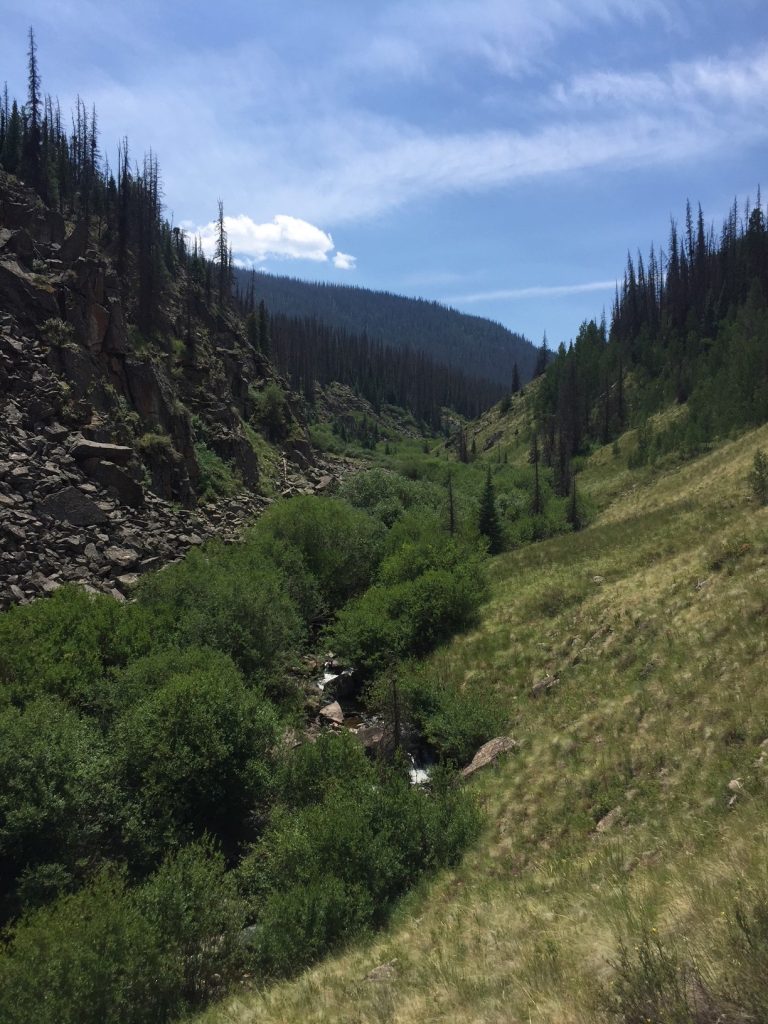
This area is rough. You must travel through Creede, Colorado, from Denver to get there, and some of the travel is gravel road. The trip takes almost five hours. There is no cell phone coverage anywhere near this area. This is untamed wilderness, and the only other things you’ll see are a few backpackers who have braved the area like you.
The hike in is sustained uphill beginning at around 9000 feet elevation. We ended the first day when we knew we were soon going to lose light and where we had a source of water. I’ll speak more about water later.
After our first night, there was a long, moderate but sustained uphill trek to begin our slog up the Continental Divide Trail (CDT).
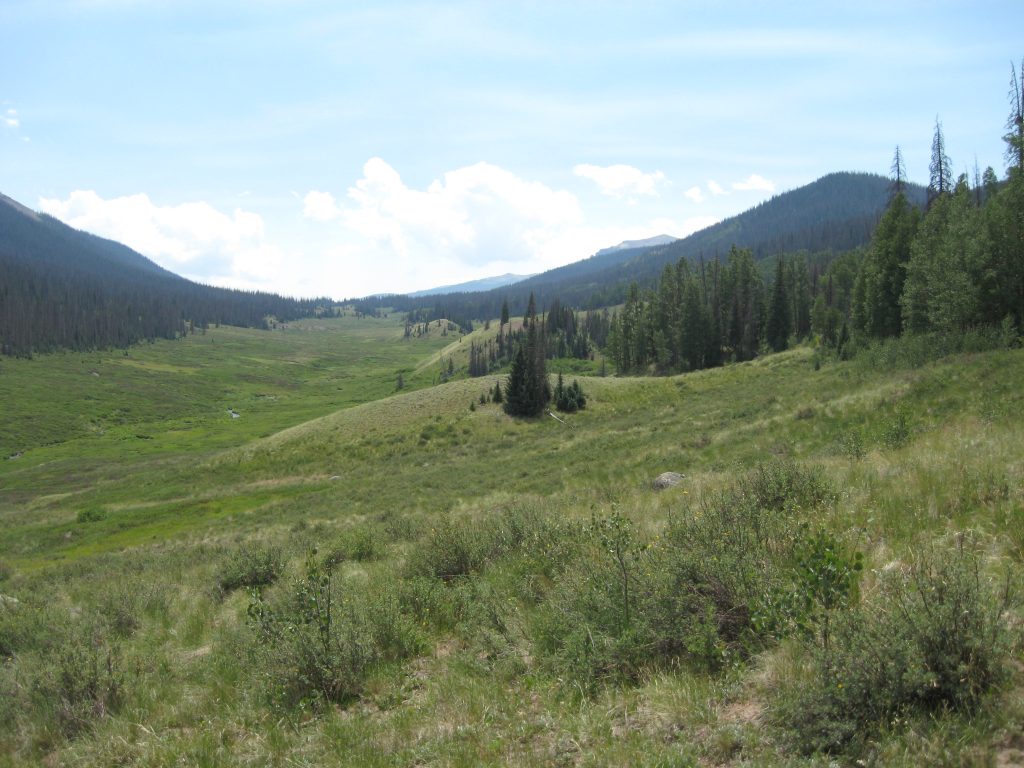
The beauty of the area is difficult to describe in words. Perhaps impossible.
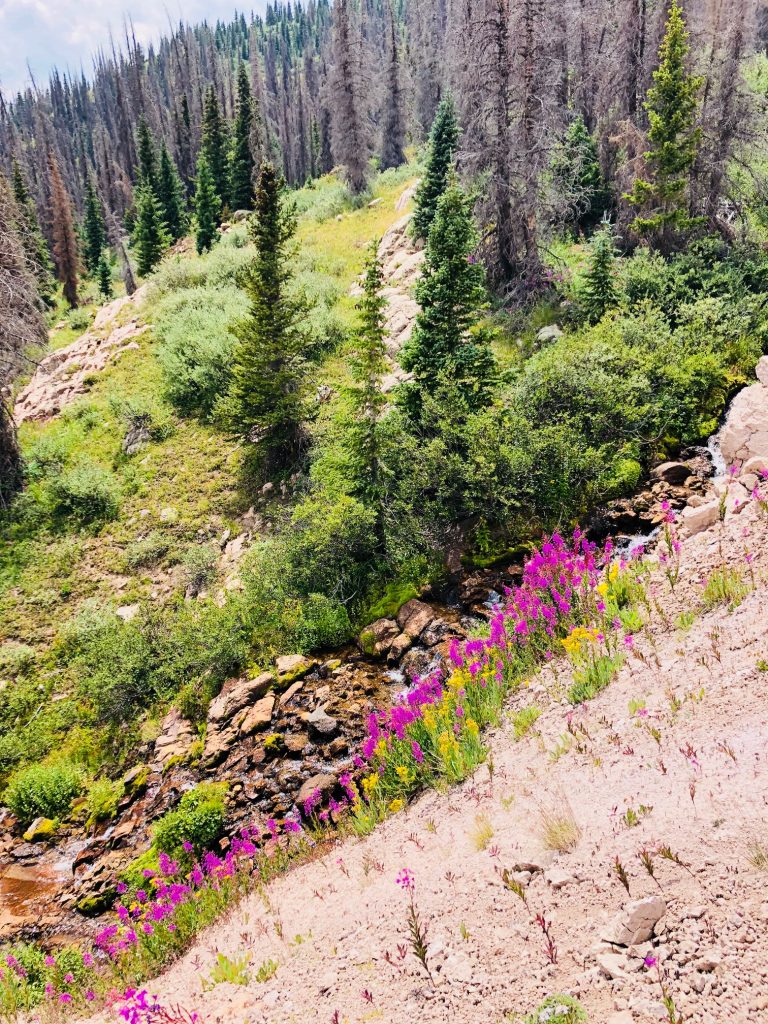
A hard right after this long, sustained uphill takes you up the CDT, towards “The Window.”
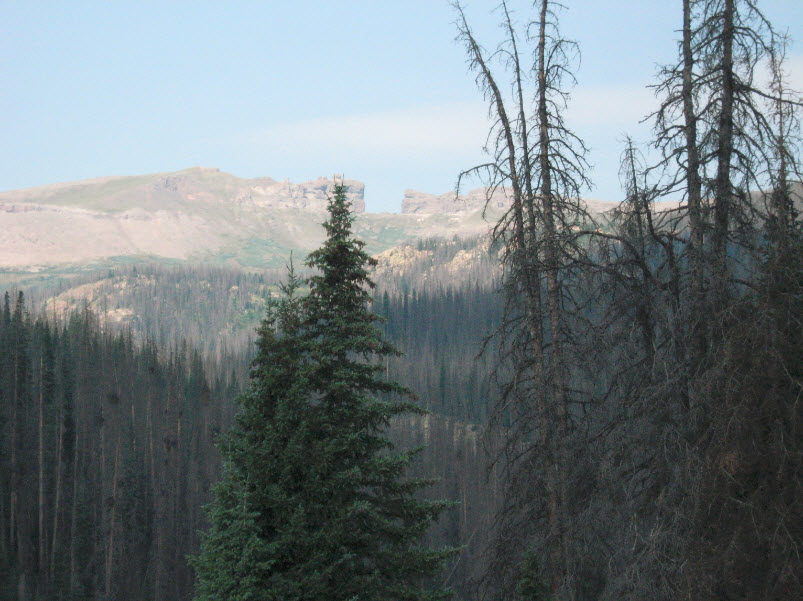
The difficulty of the uphill on the CDT is difficult to describe. It’s the longest, sustained uphill at high elevation (10,000 feet – 12,000 feet) I’ve ever done. It includes rocks, boulders, scree, downed trees, a little bushwhacking, natural gravel, undulations, loss of the elevation you just gained, only to have to regain it, river fordings, creek crossings, and on and on.
Eventually the hardest uphill begins towards Ute Lake. This is where we’d been at one point.
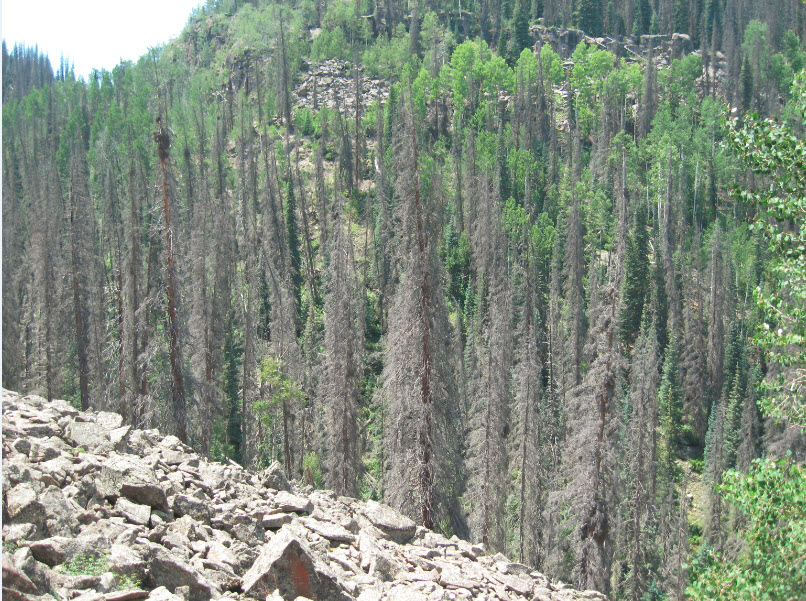
This is where we were going.
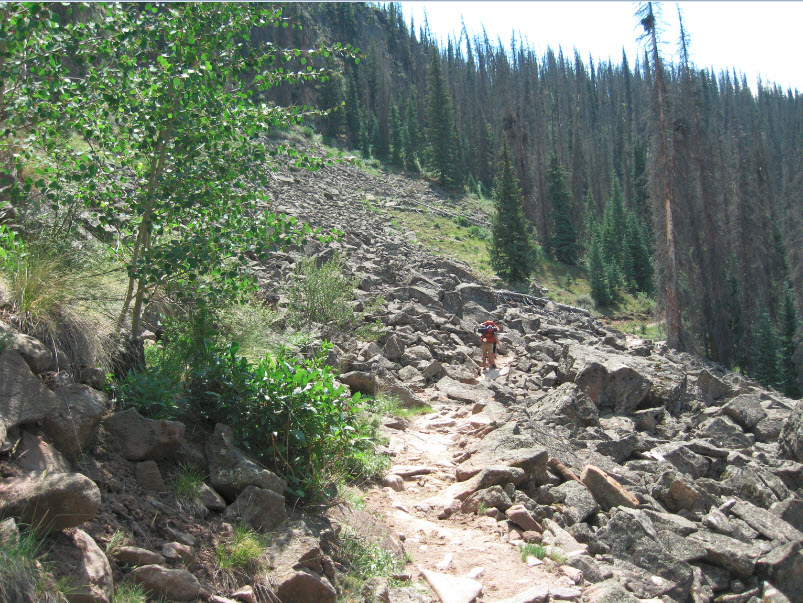
And there was much more after that as we’d find around the next turn. This hike covered more than five miles of the most intense backpacking I’ve ever done, climbing from 10,000 feet to around 12,000 feet. During the hike I was burning through 1 Liter of water every 30-45 minutes.
It’s funny how water controls your thoughts and forces your decisions. Every decision is based on sources of water. Every one. The temptation is to face-plant in the nearest stream you come across, but we resisted that temptation and filtered every time.
We passed some other backpackers who told us that the climb from the trailhead to Ute Lake was two full days. We had tried to turn two days of climbing into 1.5 days, and it wasn’t working. I was the holdup, as I’m convinced Joseph and Abe could have made it to Ute Lake, but I couldn’t. We had crossed as much water as we were going to find before the lake, and had to make it there for our final water for the day and night.
Joseph made the decision to turn around and lose elevation to the nearest stream, and it turned out to be a wise move. Over the course of the day, between uphill and downhill, we moved around eight miles, gained around 2000 feet, and lost around another 1000 feet over the same scree, boulders, and downed trees we had just crossed. It might be the roughest day I’ve ever had on the trail. All of this was done carrying 45-55 pound backpacks on our backs, depending on the amount of water we had at the time. Water is heavy.
Part of what makes this area rough is the thin air, and the heavy breathing only accelerates the water loss. We consumed an incredible amount of water, but only pissed once per day right before climbing into our sleeping bags. Orange. It was literally impossible to stay hydrated no matter how hard we tried.
The third day we made the decision to make our way out to the trailhead, another eight miles, once again never having to stop to piss. The drove back into Denver for the night, and on Friday we made a day-hike in the Rocky Mountain National Park to Lake Haiyaha.
Once again, it’s beauty is difficult to put into words.
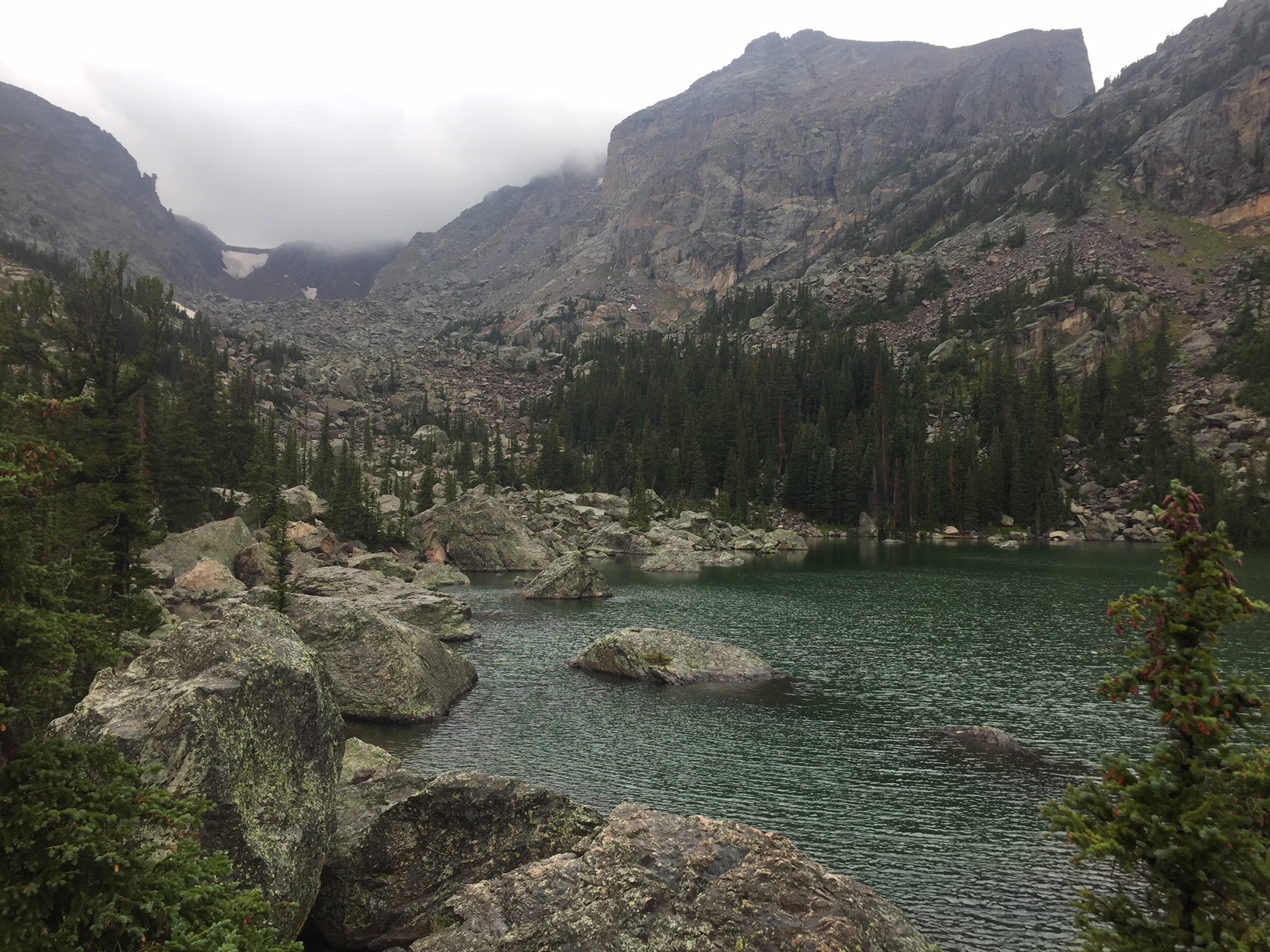
Lake Haiyaha in the rain.
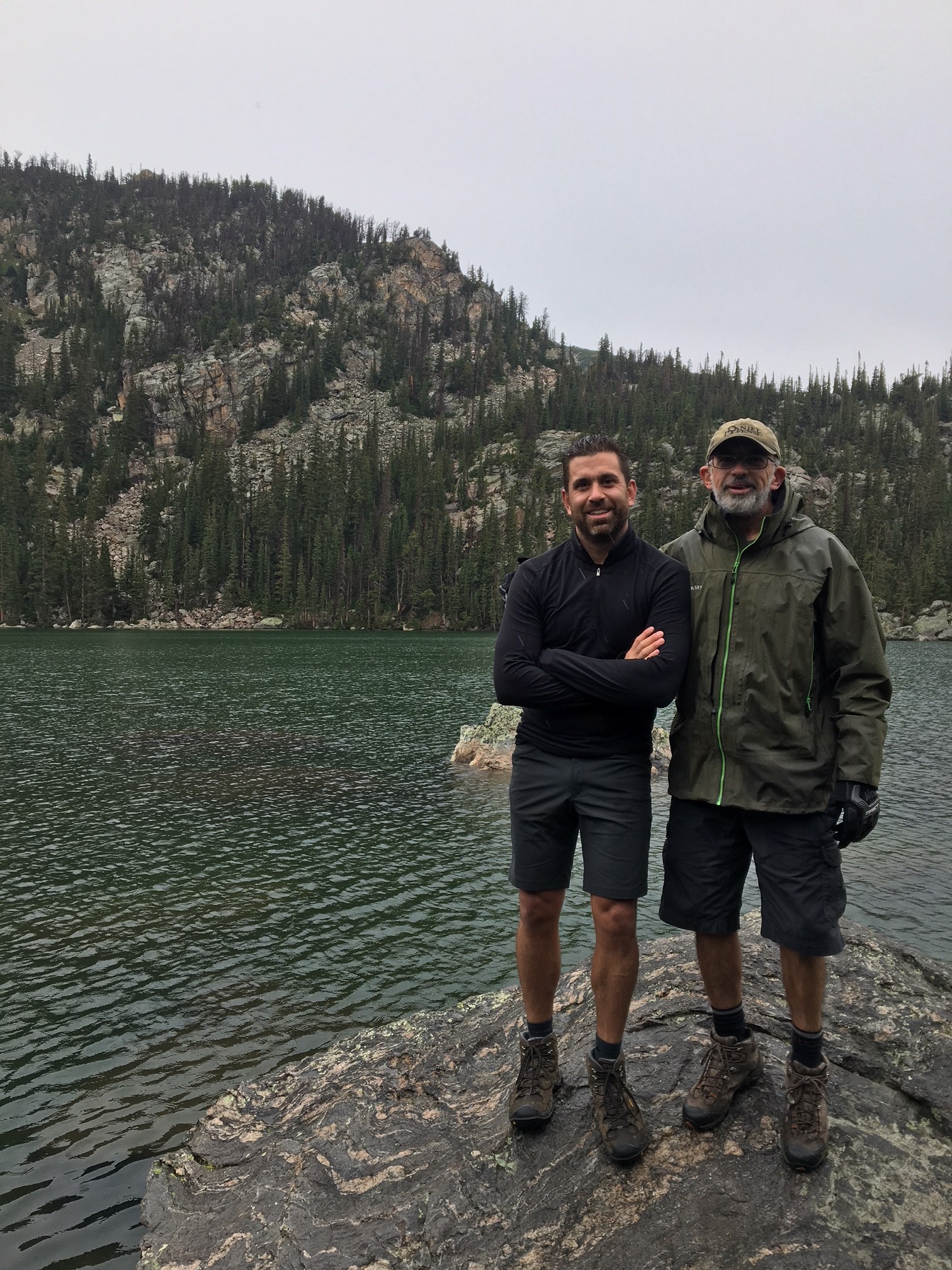
Dad and Son
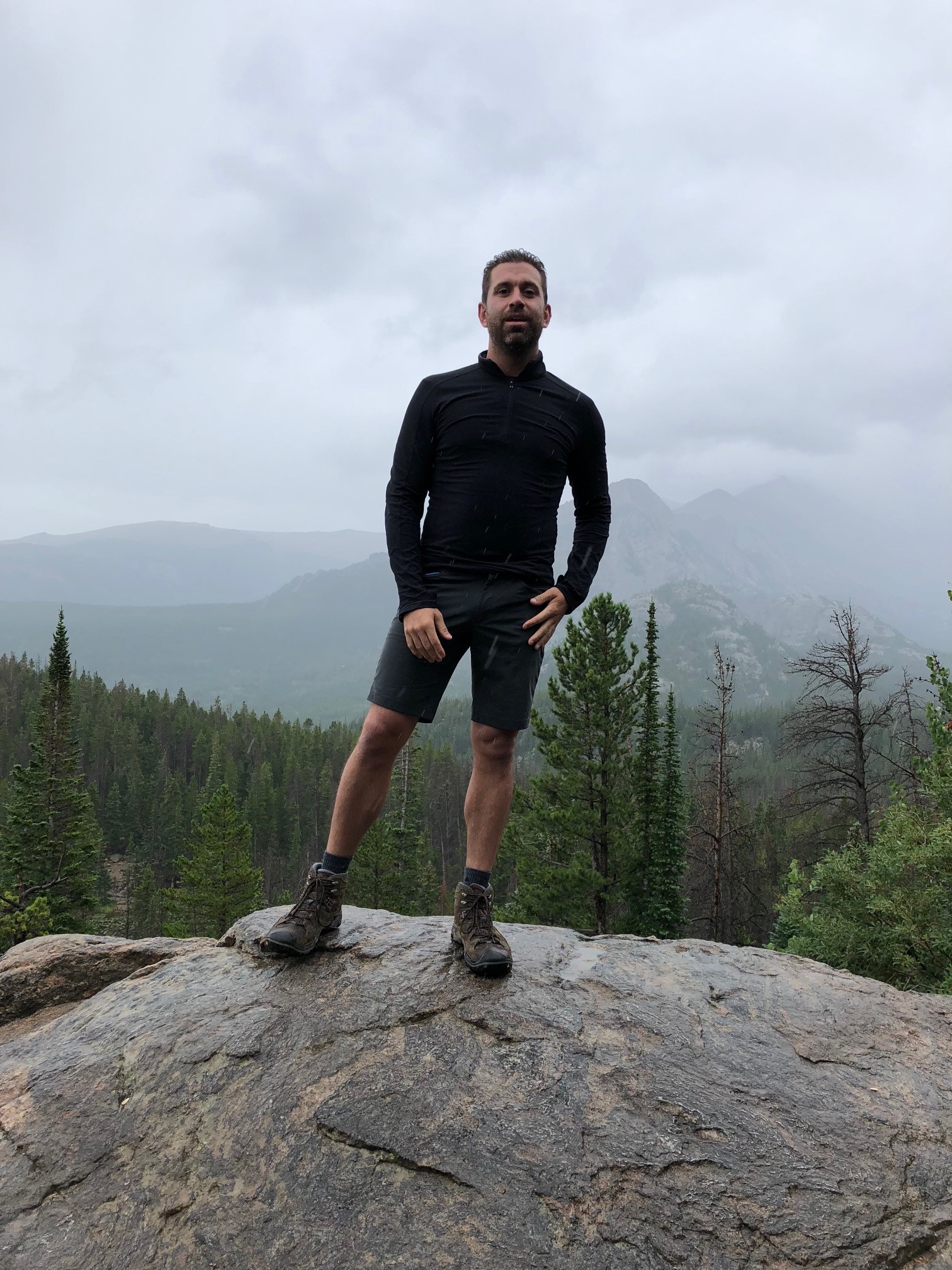
Joseph, the hiking machine.
Let’s discuss lessons learned from this adventure, as well as recommendations for equipment and training.
The Gun
I wanted to carry one of my 1911s, but decided that I wanted something more powerful than .45 ACP. We’ve discussed 450 SMC before (Short Magnum Cartridge), which is the .45 ACP with a rifle primer, leaving more room for powder. Most guys who shoot the 450 SMC out of 1911s seem to be using a 22# spring rather than the 18# spring that is typical for the 1911, so I ordered a 22# and 24# spring from Wolff Gunsprings. I also ordered some 450 SMC ammunition, as no gun store anywhere near me carried it.
I wanted to go by Hyatt Gun Shop and talk with Woody before doing this. Woody knew exactly what I was doing, recommended the 22# spring, and told me I’d be just fine with the ammo in that particular 1911. “It’s a good gun, it’s all stainless steel, and the rounds are similar in ballistics to the 460 Rowland. Just hit what you’re aiming at,” he said. I replied that I’d field stripped it and wasn’t so sure it didn’t already have a 22# spring in it. He cycled the slide once, and said, “It has the 18# spring in it. It’s difficult to tell by looking at it.” Sure enough, it did.
I field stripped my gun, installed the 22# spring, and inserted a 10-round Wilson Combat magazine for ten rounds of 450 SMC. The 22# spring makes it slightly stiffer to cycle the slide. We saw plenty of deer, Chipmunks, and other assorted wildlife, but no bear and no moose. There were times when my partners went on ahead of me and I solo-hiked, but I would have been fine with that setup when in any danger.
Travelling With Firearms, And The Stupidity Of The TSA
We don’t have any complaints against the TSA in Austin, TX. They seemed relaxed and not too puckered about guns, and used to seeing them.
Charlotte, no so much. The airline employees who used to check firearms now “feel uncomfortable” doing it, so call a TSA representative. The TSA employee who checked my gun actually seemed to know something about guns (he remarked that I had a chamber flag in the gun), but he was a bit puckered for my tastes.
He tried to pry open the box, got it a centimeter or two open on one end, and told me it didn’t meet TSA standards because the gun could be taken out of its box. I doubt it. I think he was exaggerating. Fortunately, I had a cable and another lock, so I wrapped the cable around the handle and locked it where he couldn’t pry it open at all. If I had not had the extra cable and lock I would have missed my flight.
Denver is just downright stupid. Checking a gun means having a airline employee take your luggage at a glacial pace to another room where it gets put through an X-Ray machine. She then asked if the gun was unloaded and locked, to which we said “yes,” and then she lets the same airline employee take your luggage back to a conveyor. At this point he slams it down on the conveyor and walks away leaving the luggage there unattended. Joseph and I decided to stay with our luggage until the belt started a little later moving our luggage behind the wall. We weren’t going to walk away until we saw that our luggage had disappeared.
I would have loved to ask the TSA lady what she thought she was looking for. If this is like every other airport, every piece of luggage is X-Rayed. But what she accomplished besides the typical X-Ray every piece of luggage gets is beyond me. All she did was ask us questions the airline employee could have asked. Our luggage was never opened, the gun was never inspected. Not, by the way, that I think the TSA regulations make any sense or it’s necessary for the gun to be in any certain configuration or inspected at all.
Let’s face it, folks. Since we are dropping off the luggage and we are picking it up, the only necessity for the luggage to be locked up is what happens behind the wall. The only good of locking up the gun is theft by airport employees. We know it, the TSA knows it, and the airlines know it. It’s the truth. None of this has anything to do with security. It’s all about airport theft by airline or airport employees.
From there we went to the Denver security checkpoint. One TSA employee was running up and down the line, up and down the line, up and down the line, back and forth, to and fro, with a dog (presumably a bomb-sniffing dog) stopping whenever the dog wanted to stop. One lady turned to me and said, “It makes me so scared to go anywhere these days.”
I responded, “I’m not scared. This is all theater, designed and built to make you think certain things.” She gave me a puzzled look and moved on. When asked for my driver’s license, I showed it to the TSA employee, who then said “take it out of your wallet” (it had a window). I rolled my eyes, which apparently he didn’t like.
He said, “Always take it out. How we ‘posed to know if it’s paper or not? Rememba ‘dat.” My immediate thought was “How are you ‘posed to know whether any information I’m presenting to you is real rather than a complete fabrication, you imperious imbecile?” I didn’t say that as it would have caused me to miss my flight. I pick my fights.
Lessons Learned (And Relearned)
The temperature varied between 40 and 70 degrees F, and we ran into some rain. I cannot say enough about the best parka I have been able to find, which is made by a fishing company. My particular parka is no longer made, but one similar to it is. It’s expensive, but it was worth every penny. I like to buy mine “blousy” to fit fleece or other clothing underneath it.
Put my water filter in an attachment bag on the outside of my backpack. It drips water just a little and I don’t like the contents of my backpack getting wet.
From the picture above you can see that I carried my gun in a Hill People bag on my chest. This works for a while but after three days it began to bother me. In the future I’ll rig up a holster to my backpack belt with zip ties or some other method for carry.
I carried a tactical light. In the future I won’t. When ounces matter, aluminum light housing and batteries are at a premium for weight. It’s a big commitment to carry that weight, even if the light is fairly small. There is no point in using a tactical light in camp. It’s so bright that it’s blinding. Headlamps and small lights are fine for camp, and the only need for a tactical light is on your gun rail with a single 123 battery (like my Streamlight).
Don’t go cheap on important equipment like a hydration pack. Joseph and Abe had good ones. I didn’t, and I suffered for it. Water (and the ability to get to it) is everything.
The importance of trekking poles. Joseph and Abe didn’t use trekking poles, but I did. I couldn’t have made the hike without them. My triceps doubled for another set of thighs.
Equipment. We are all experienced backpackers and hikers. We all have either Keen or Oboz boots. There may be other good ones out there, but I advise against experimentation. Get the best. Many of my readers like tactical equipment. But mostly, tactical equipment sucks. The civilian backpacking community has more money to spend, has done more research, and has invested more time and energy into making better equipment than the military community. Dump your combat boots and get Keen or Oboz. Keen for a slightly wider foot, Oboz for a more narrow or normal foot like mine.
All three of us were running Osprey 50L backpacks. Dump your tactical packs, folks. They’re no good. No one who does this carries tactical packs. No one. No one on the trail has something like that. If you’re running combat boots, you’re destroying your feet for no good reason. If you’re running tactical packs, you’re destroying your spine for no good reason except that you’re unable to break with the community that trained you. The community that trained you gave you equipment that sucks. Accept that, and change.
Teamwork. The slowest man holds everyone up. I know that. I was the slowest man. In camp, everyone has to pull his own weight. There are no slouches on the trail. There’s too much to do. Making camp means processing wood for a fire, filtering water, setting up tents and/or tarps, preparing food and a host of other things. We divided responsibilities and got busy when we dropped our packs. There are no socialists in the bush.
Because it means hard work, responsibility and productivity, meeting obligations and learning to survive, every man who is capable should do this with their sons. What? You didn’t think that Marines are made by the US Marine Corps, did you? That’s completely false. Marines are made by fathers. The Corps just sharpens the blade.
Carry multiple means of fire starter on different parts of your body or kit. If one gets wet, you have another. That happened to me on this trip.
Physical conditioning is everything. To prepare for this trip I hiked, biked, worked out in the gym three or four days a week, and swam. My preparations seemed endless. For a 58 year old man with rheumatoid arthritis, I did okay. But I was equivalent to other hikers on the trail. In other words, I couldn’t turn what most of the hikers know to be a two day climb into a one and a half day climb. The rocks, boulders, scree, streams, rivers, downed trees and thin air worked too hard against me.
A moment of honesty is in order. Some folks in the patriot community talk about wearing body armor, whether soft or plate. Don’t even discuss that, don’t even consider that, if you can’t strap on a 50 pound pack and make a climb, perhaps not this difficult, but one like it.
You might be able to shoot 1 MOA, but if you’re injured or dead, you’re no good to anybody. Every part of my body hurt – triceps, hips, thighs, back, everything. When you’re exhausted, you make moves that aren’t supported by the muscles, and twisting moves especially can cause real problems for your frame. Get in shape, or drop the notions of suiting up in armor. It won’t help you if you can’t carry it. Muscle strength is good, and while I used to be on the powerlifting team in college, I’ve lost some of that muscle mass. Fitness can partially make up for loss of muscle mass over the years, but nothing can make up for lack of fitness.
Gloves. I wore Mechanix Impact gloves, and as I had to pound and hit the boulders more than once to keep my balance, it saved my hands.
Finally and again, the TSA is an irredeemable clown show.
Conclusion
“For every beast of the forest is mine, the cattle on a thousand hills … And everything that moves in the field is mine … For the world is mine, and all it contains.”
God is the maker of all I saw, of everything I admired and everything that astonished me. He has made it for His glory, and for my edification. He had made the world to give it over to mankind for his own dominion according to His holy law.
What men may think about where this all came from is of no consequence to God, who scoffs at His detractors. Our opinions only have consequences for us and will be our judgment. I am thankful to the Almighty for giving me this opportunity to honor and worship Him in this way. He is the God of the universe, and my personal Lord. Even if he slays me, yet will I serve Him.





On August 6, 2018 at 7:16 am, Old Bill said:
Great summary & observations! Thanks!
On August 6, 2018 at 11:59 am, Sam said:
Fantastic writeup, solid observations. Thanks for sharing, and I’m glad it was such a great trip!
On August 6, 2018 at 6:32 pm, Pat Hines said:
Amen.
On August 7, 2018 at 5:43 am, anonymous said:
Thank you for the detailed account of your trip. You are lucky you have a child that has the same outdoor interests that you have. So many of us (myself) included figured that if we took our children out when they were young, they would grow to appreciate and enjoy the same things we do.
No necessarily the case, unfortunately. They gain their own interests, just like we did.
I hope the trip gives the three of you great memories of your trip. For an ‘old dude’, you did very well with a pack that size traversing that terrain. Flat land isn’t nearly as hard as up and down – you get a Gold Star ! :^) The pictures look incredible.
On August 7, 2018 at 9:53 am, JoeFour said:
Great post! Quick question–what water filtration unit did you use?
On August 7, 2018 at 10:13 am, Herschel Smith said:
@JoeFour,
Good question. I’ll have to dig it up and text it to you. It removes bacteria, protozoa, turbidity, etc., but there are better ones on the market today that profess to remove viruses.
Whether they do is a different issue. I’ve drank out of virtual mud puddles and never had a problem.
On August 7, 2018 at 10:25 am, PaulB said:
I would not fly to anywhere in the CONUS. I will not submit myself to that clown show called TSA.
That being said, this is a good write up. Glad you had a good time in Colorado.
On August 7, 2018 at 10:26 am, Herschel Smith said:
@Old Bill, @ Sam,
Thanks!
@ anon,
Yes, I’m blessed.
@PaulB,
I considered driving. It would just have taken far too long given our time and work limitations.
On August 7, 2018 at 11:04 am, BRVTVS said:
About trekking poles or a hiking staff (my own preference), the extra assistance to the legs is only one benefit. The benefit of stability over rough or unstable ground is a huge plus. I am certain I’ve avoided several falls in rough terrain over the years. I consider them to be the most important safety equipment one can have on the trails. I no longer go hiking without one.
On August 7, 2018 at 11:08 am, Herschel Smith said:
@BRVTVS,
I fully agree.
The kids don’t seem to use them as much, but that’s okay with me. I’ll carry what I need to make the trek.
On August 7, 2018 at 2:38 pm, intheaspens said:
We hiked/camped the Weminuche many years ago – it was beautiful. Congratulations on your trip. I’ll never forget ours.
On August 7, 2018 at 3:34 pm, Jonathan said:
Thank you for a great article. The honesty and equipment discussion that you provide was very helpful.
I haven’t been in the mountains, of anywhere except West Virginia, for too many years; I miss Idaho, Montana, and Colorado.
On August 8, 2018 at 7:09 am, CA said:
Posted. Great stuff.
Might you consider a standalone post on the PT you did to get to that capability?
It would be very relevant.
On August 8, 2018 at 7:30 am, Annoyed Max said:
A great read, with lessons. Thank you very much.
On August 8, 2018 at 7:49 am, SGT.NAG said:
Glad you survived. I fell on some ice at Bright Angel Trail in 2017. Displaced scapula and destroyed my rotator cuff. $100 grand in doctors bills and lost wages. Worth every penny.
Hill People makes a strap to attach the Kit bag to your backpack that way it doesn”t start feeling like a boat anchor on your neck. Minimal, Minimal, Minimal.
Thanks for sharing and remember you can’t cheat the mountain.
On August 8, 2018 at 10:04 am, SemperFi, 0321 said:
Great writeup.
I just turned 64 2 weeks ago and have made 3 backpacking trips this summer already in the Wind Rivers of Wyoming, I also do Yellowstone NP since I live so close (40 miles).
Western Mtneering 10′ down sleeping bag, Osprey Atmos 65L pack and Big Agnes 3 lb tent are my go to gear now, full pack weight of about 35 lbs with my dogs gear too. I have mild COPD/Asthma and hike constantly as physical therapy since I live at 7,000′ and hike above 11,000′ sometimes. The weight and elevation are getting to me as I get older.
Around here I carry a G20 with nuclear 200 gr handloads. If I were to start over I’d opt for the .460 Rowland in a SA XD. See lots of grizz tracks but no actual encounter yet.
Trekking poles are a necessity, especially for river crossings. Slipping with a 30-40 lb pack on can be fatal. Also carry water shoes, I’ve used Tevas for years but am looking for something lighter.
I carry a First Need water pump filter, gives instant filtered water and as fast as you can pump.
Getting older means we need to keep doing this more, it is physical therapy and also a means of enjoying life to it’s fullest.
Give me a shout if you want to try the Winds or YNP.
On August 8, 2018 at 10:30 am, Bill Robbins said:
Great stuff, from start to finish. Thank you for the write-up.
On August 8, 2018 at 10:32 am, Herschel Smith said:
@SemperFi,
Yea, I have a Big Agnes inflatable sleeping pad. They make nice stuff. For tents and bags there are a number of good options, North Face, Nemo, Mountain Hardwear, etc.
I felt very comfortable with 450 SMC, 230 grain loads with published velocity of 1130 FPS out of a 5″ barrel. Ten rounds.
Tevas are too heavy. I carried river shoes. Keen makes a nice one, light too. Carried them on the back of my pack for accessibility.
I should also mention that putting my filter in a pouch on the exterior of my pack would have made it more accessible, where I wouldn’t have had to drop my pack to get to it.
Joseph has a Nemo down sleeping bag and Nemo tent. Good quality stuff.
I may take you up on that offer to hike in Wind Rivers one day.
On August 8, 2018 at 11:33 am, George True said:
The Weminuche is one of the wildest and most beautiful areas in the Lower 48. I used to do a lot of alpine mountaineering, and the high thirteeners of the Trinity Peaks area is a mountaineer’s paradise. At age 67, I do not do much hard stuff anymore, but I still plan to do an annual trip into the Weminuche for as long as I am able.
Good points made about getting the best quality boots and backpack that money can buy. A well designed and properly fitted internal frame backpack can make 55 lbs feel like 35 lbs on your back. And even for the younger guys, I feel that trekking poles are an absolute must. They will save your knees from wear and tear that is cumulative. Even one pole makes a world of difference. Twenty five years ago, I had to hike out of the Weminuche with a sprained knee, using a tree branch as a staff. It took a long time, nd was a miserably painful experience. A pair of trekking poles would have been a godsend. After that, I started using poles,
On August 8, 2018 at 12:08 pm, Oldfart said:
Those trekking poles are convenient but have one glaring (to me) disadvantage: In a real emergency they don’t burn. I use a long cedar splinter that I found after the Mt, Saint Helens eruption. It’s light and if I have to I can start a fire with it.
On August 8, 2018 at 1:14 pm, Tom said:
Thanks for posting. I don’t leave my mountains now but I remember the Wasatch and the beauty those western mountains hold. Favorite line ever, hiking at about 8-9k feet on a trail crossing a scree field via switchbacks, 3 riders on horseback came up behind us. We moved aside at the next turn and the first two riders passed just fine, but as the third came through his horse began to lose purchase. The guide who was up front at the point said “Get that fcking horse back on the trail now!”. Which caused nervous rider number 3 to get his act together which was a good thing given the position. The horse let out a huge fart and he was back on the trail. Without missing a beat, mr. guide turned to us and said “A horse that farts is a horse that won’t tire, a man that farts well that’s the man to hire.” See ya on the other side, God bless!
On August 8, 2018 at 1:52 pm, JJ said:
Great write up of your adventure. Beautiful scenery.
Now that I live in Texas, the thing I miss about living in southern Missouri is the abundance of hiking trails in the forests and mountains there.
On August 8, 2018 at 7:53 pm, Praxis said:
I’ve had my ass handed to me in the Weminuchie. Early freak snow storm during a 6-day ‘ultra-light’ trip in late August. Thankfully the storm hit the first night before we crossed the divide on the way in from Elk Park. We bailed back to to Durango/Silverado rail line. By morning about two dozen backpackers geared up heavier than us also made prudent decisions. I don’t mind winter mountaineering when I’m geared up for it. I’ve also experienced bad lightening on the way to Vestal and mud slides covering the Million Dollar highway and bad avalanches climbing above Silverton on Stairway to Heaven. Those are serious mountains. Glad it all worked out.
On August 8, 2018 at 8:30 pm, Centurion_Cornelius said:
“The heavens and earth proclaim His glory!”
On August 8, 2018 at 9:32 pm, Herschel Smith said:
@Praxis,
It’s a humbling place to be. You don’t go in there unprepared, or you won’t come out alive.
On August 8, 2018 at 10:46 pm, Herschel Smith said:
I should have mentioned one more thing in the article. Wool socks. “Darn Tough” is the best thing going. Nothing but wool. Don’t wear cotton, unless it’s a cotton-Nylon blend. Wicking, synthetic shirts. GoreTex at night.
On August 8, 2018 at 11:57 pm, Stealth Spaniel said:
In my young years, I loved hiking, always took the dogs too. Now that I had my right knee replaced, and the left knee being done in October, I doubt that I will ever really hike again. But, I enjoyed this article no end. There is something about being in God’s unspoiled creation that builds and renews all of us. Maybe, in a year or two, I might try going someplace on horseback.
On August 9, 2018 at 6:26 pm, pdxr13 said:
+1 on trekking poles. Modern material ones are very light compared to wood, and may double as tent poles for the gram-shavers. Pack advice: agree completely. Tactical packs are designed heavy to carry insane weight and stand up to Devil Dogs chewing on them. The ILBE and FILBE have good padding/suspension, but are too heavy for a 55# target load. Spending a few hundred dollars to save 3# of extra-unneeded pack weight-strength is well-spent for a trip like yours.
Thanks for the pictures!
On August 10, 2018 at 9:59 pm, Herschel Smith said:
@pdxr13,
And the Osprey has a nice netting along with the curved internal frame to lift the pack off of your back. It’s not possible to keep from sweating your back, but this comes as close as anything I’ve found.
With its straps and other means of attachment you could put a heavier load than the 55# we had (perhaps 60# for the heaviest load with water), but you’re right, I’m a gram-shaver. Not ultralight, but I’m interested in literally everything I can do to shave weight. I could see a 75# or more load on this pack, and then Osprey also makes a 70L backpack. But my perspective is that if I’m carrying that much stuff, I’m carrying too much.
I just can’t make a climb like that without shaving weight where I can.
I should also mention that if I go into this are again, it’s SO ISOLATED and rugged that I would consider carrying means of Comms with other members of my team. I don’t like the idea of getting separated.
It’s legal to hunt on National Forest land, and I had wondered why there is none in this area (perhaps there is some regulation against it in this specific place, IDK). And then it dawned on me.
It would make absolutely no sense to hunt this area. You can go for days INTO this wilderness, and still be days from any other trail head. If you took game, it would be impossible to clean it and get the meat out without spoiling. And you would draw predators.
On September 23, 2018 at 4:22 am, Walt Browning said:
Thank you for an honest and inspiring story. Valuable lessons learned and shared. I will take your advice, especially on the need for PT over anything else.
Spot on recommendation for the Keen boots. I’ve got a wide foot. They are incredible.
You reinforced the truth that it is not the gun, but the man behind it that is the real weapon. Tools are useless in the wrong hands.
Stay true to the Lord and bless your family and friends.
On September 27, 2018 at 5:58 pm, Robert W Parish said:
Excellent writeup! I have hiked many trails and this did justice to the experience. Thank you for sharing your learnings and eternal focus.
On September 30, 2018 at 7:11 am, joe said:
aku makes some really good boots also…
On October 7, 2018 at 11:23 am, Badger said:
What a wonderful piece of writing; right mix of candor, self-deprecating humor, and joy of doing a really neat thing with people special to you. 2x thumbs-up sir!
On November 26, 2018 at 11:41 pm, BRVTVS said:
Do you have to change the spring in your 1911 back to original to properly cycle 45acp?
On December 7, 2018 at 1:30 pm, PatDig said:
Great write up about a great trip. Hope to do the same with my kids when they get older. Love the honesty.
On December 7, 2018 at 11:32 pm, Bill Chunko said:
I spent an entire summer backpacking and climbing in the Weminuche Wilderness as a trainee instructor for Outward Bound in 1974. It is incredibly rugged and remote. I didn’t carry a firearm at the time, but there were times years afterwards, still not carrying, that I really wished I had. I won’t make that mistake again.
On December 8, 2018 at 12:04 am, TheAlaskan said:
Looks like a lot of beetle kill….White spruce?
On May 27, 2019 at 6:39 pm, max blancke said:
That is right in my backyard. I recognize most of the places pictured, as I spent a pretty large portion of my childhood up there.
The secret to travel in the Weminuche is to do most of your travel by horse.
On October 26, 2019 at 8:48 am, Iron Monkey said:
Did you hear about the new Colorado wall? It will be called Cologuard.
All clowning around aside that is a beautiful place and added to the bucketlist.
Lost 130lbs. since March of 2018 just from hiking/walking and cleaning up diet of all Frankenfoods.
Being a big marshmallow will be dangerous when Spicy Time jumps off.